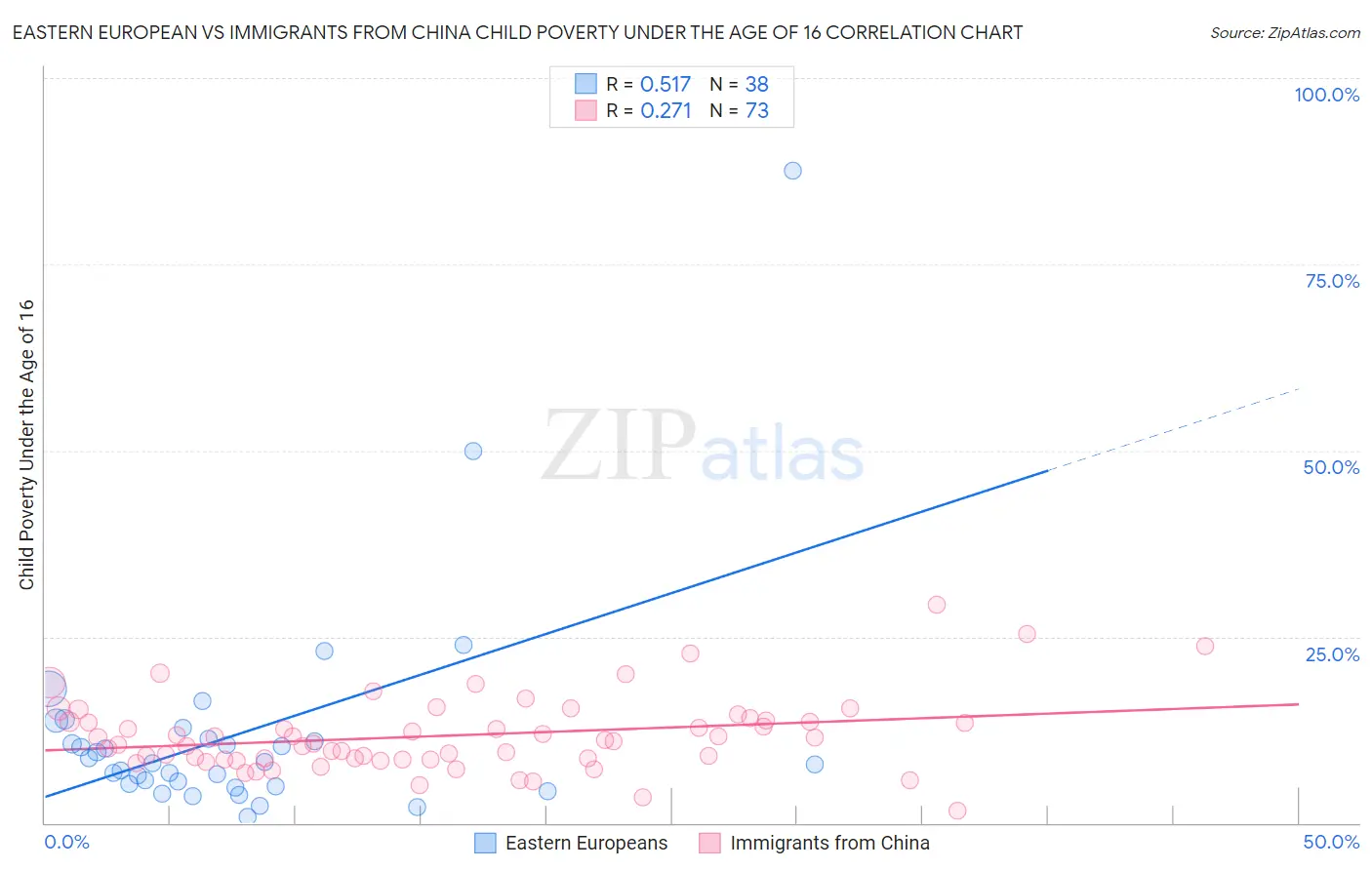Eastern European vs Immigrants from China Child Poverty Under the Age of 16
COMPARE
Eastern European
Immigrants from China
Child Poverty Under the Age of 16
Child Poverty Under the Age of 16 Comparison
Eastern Europeans
Immigrants from China
13.2%
CHILD POVERTY UNDER THE AGE OF 16
99.8/ 100
METRIC RATING
25th/ 347
METRIC RANK
13.3%
CHILD POVERTY UNDER THE AGE OF 16
99.8/ 100
METRIC RATING
27th/ 347
METRIC RANK
Eastern European vs Immigrants from China Child Poverty Under the Age of 16 Correlation Chart
The statistical analysis conducted on geographies consisting of 454,217,761 people shows a substantial positive correlation between the proportion of Eastern Europeans and poverty level among children under the age of 16 in the United States with a correlation coefficient (R) of 0.517 and weighted average of 13.2%. Similarly, the statistical analysis conducted on geographies consisting of 450,826,325 people shows a weak positive correlation between the proportion of Immigrants from China and poverty level among children under the age of 16 in the United States with a correlation coefficient (R) of 0.271 and weighted average of 13.3%, a difference of 0.71%.

Child Poverty Under the Age of 16 Correlation Summary
| Measurement | Eastern European | Immigrants from China |
| Minimum | 0.77% | 1.6% |
| Maximum | 87.5% | 29.3% |
| Range | 86.7% | 27.7% |
| Mean | 12.0% | 11.7% |
| Median | 8.1% | 11.0% |
| Interquartile 25% (IQ1) | 5.2% | 8.5% |
| Interquartile 75% (IQ3) | 11.3% | 13.7% |
| Interquartile Range (IQR) | 6.1% | 5.2% |
| Standard Deviation (Sample) | 15.2% | 5.0% |
| Standard Deviation (Population) | 15.0% | 5.0% |
Demographics Similar to Eastern Europeans and Immigrants from China by Child Poverty Under the Age of 16
In terms of child poverty under the age of 16, the demographic groups most similar to Eastern Europeans are Latvian (13.2%, a difference of 0.080%), Indian (Asian) (13.1%, a difference of 0.29%), Maltese (13.1%, a difference of 0.33%), Immigrants from Eastern Asia (13.1%, a difference of 0.41%), and Bolivian (13.2%, a difference of 0.42%). Similarly, the demographic groups most similar to Immigrants from China are Assyrian/Chaldean/Syriac (13.3%, a difference of 0.24%), Bolivian (13.2%, a difference of 0.29%), Swedish (13.3%, a difference of 0.42%), Turkish (13.4%, a difference of 0.72%), and Latvian (13.2%, a difference of 0.79%).
| Demographics | Rating | Rank | Child Poverty Under the Age of 16 |
| Norwegians | 99.9 /100 | #16 | Exceptional 13.0% |
| Bulgarians | 99.9 /100 | #17 | Exceptional 13.0% |
| Cypriots | 99.9 /100 | #18 | Exceptional 13.0% |
| Immigrants | Japan | 99.8 /100 | #19 | Exceptional 13.0% |
| Okinawans | 99.8 /100 | #20 | Exceptional 13.1% |
| Immigrants | Eastern Asia | 99.8 /100 | #21 | Exceptional 13.1% |
| Maltese | 99.8 /100 | #22 | Exceptional 13.1% |
| Indians (Asian) | 99.8 /100 | #23 | Exceptional 13.1% |
| Latvians | 99.8 /100 | #24 | Exceptional 13.2% |
| Eastern Europeans | 99.8 /100 | #25 | Exceptional 13.2% |
| Bolivians | 99.8 /100 | #26 | Exceptional 13.2% |
| Immigrants | China | 99.8 /100 | #27 | Exceptional 13.3% |
| Assyrians/Chaldeans/Syriacs | 99.7 /100 | #28 | Exceptional 13.3% |
| Swedes | 99.7 /100 | #29 | Exceptional 13.3% |
| Turks | 99.7 /100 | #30 | Exceptional 13.4% |
| Danes | 99.7 /100 | #31 | Exceptional 13.4% |
| Tongans | 99.7 /100 | #32 | Exceptional 13.4% |
| Asians | 99.6 /100 | #33 | Exceptional 13.5% |
| Russians | 99.6 /100 | #34 | Exceptional 13.5% |
| Lithuanians | 99.6 /100 | #35 | Exceptional 13.5% |
| Immigrants | Northern Europe | 99.6 /100 | #36 | Exceptional 13.6% |